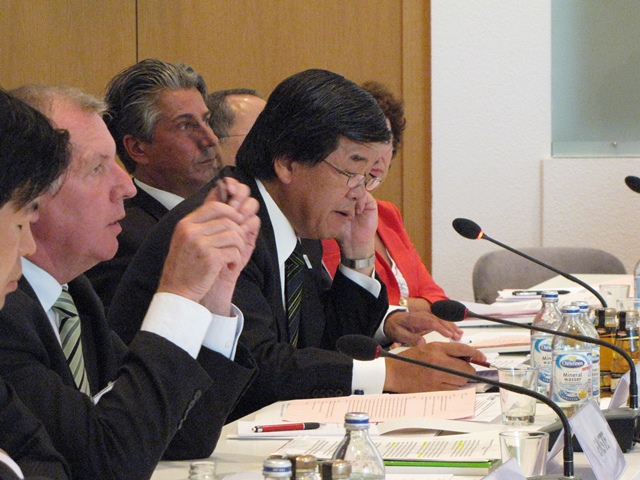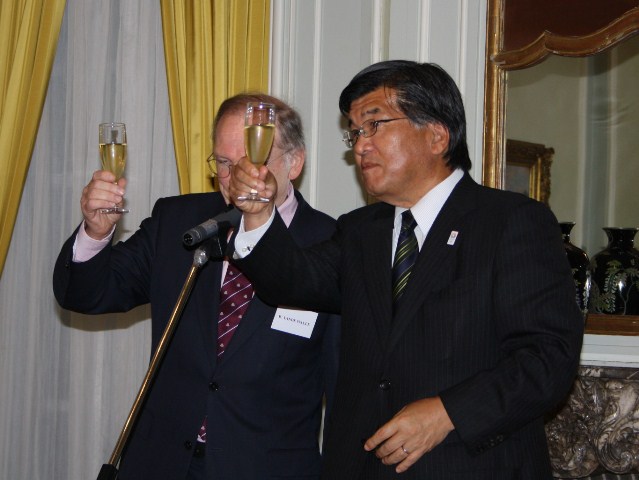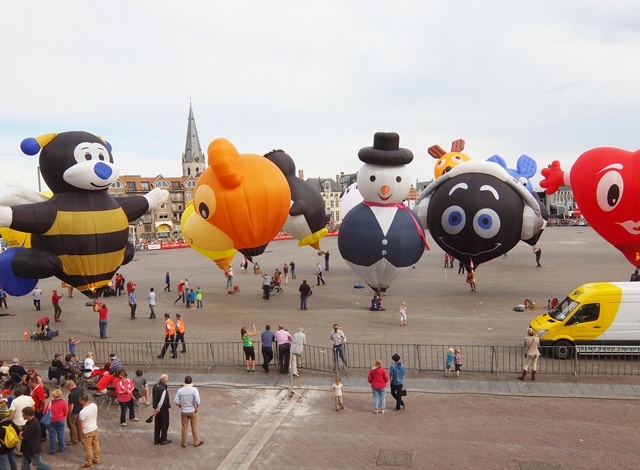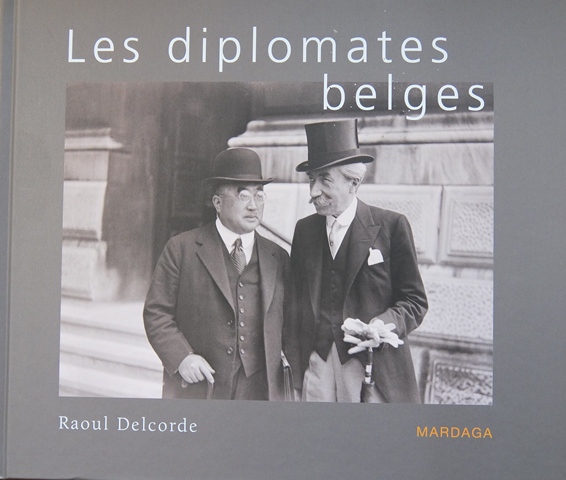|
The “Friends of Japan”, A newly created gathering (No.29)
12th of September 2013
It seldom happens that fun is combined with actual profit, but, in my case, this comes true when I am invited to a golf event as a part of work. Moreover, if this happens twice consecutively, it is a miraculous delight. The other day, I was invited as a senior guest to an international junior golf tournament, which was sponsored by a Japanese car manufacturer and where I played a round with a Belgian boy of 15 years old on the first day in a friendship event. More than 100 young people, mainly from Europe, gathered at a golf course outside Brussels to compete with each other. As these golf boys and girls were selected by each country, I saw high-level play from up close. Another event was the friendship golf tournament between locals and diplomatic corps held at the ”Flanders Japan Club” in Hasselt (90 km northeast of Brussels) (a golf course that was established 21 years ago for the purpose of strengthening business relationships with Japan). It is an annual event to which many business people from Limburg are invited and I was able to get better acquainted with them at the Governor’s reception. I am very glad to expand my circle of friends through sports.
< The Japan-NATO Relationship I Talked About In Berlin >
 Last week, I attended a NATO-related seminar held in Berlin, the capital of Germany, where I gave a keynote speech with the theme “The Relationship between Japan and NATO” at the beginning of the seminar. This seminar was organized by the Japanese-German Centre Berlin (a private research institute founded by the agreement between the Japanese Prime Minister Yasuhiro NAKASONE and the German Prime Minister Helmut Kohl in 1985) and the majority of the attendees were scholars and researchers. What was interesting in the discussion was how missile defence systems deployed by NATO in Eastern Europe and by Japan and the US in the Sea of Japan have an impact on the nuclear disarmament efforts worldwide and on the relationship with Russia and China. Last week, I attended a NATO-related seminar held in Berlin, the capital of Germany, where I gave a keynote speech with the theme “The Relationship between Japan and NATO” at the beginning of the seminar. This seminar was organized by the Japanese-German Centre Berlin (a private research institute founded by the agreement between the Japanese Prime Minister Yasuhiro NAKASONE and the German Prime Minister Helmut Kohl in 1985) and the majority of the attendees were scholars and researchers. What was interesting in the discussion was how missile defence systems deployed by NATO in Eastern Europe and by Japan and the US in the Sea of Japan have an impact on the nuclear disarmament efforts worldwide and on the relationship with Russia and China.
For a non-nuclear country like Japan, it can be said that missile defence is the only way of defence to a nuclear attack from abroad, but on the other hand the negative influence was also pointed out, such as the stagnation in nuclear disarmament and triggering non-nuclear military build-up. It is a typical example of the case having both positive and negative sides, depending on the way you look at it. By the way, for me, who visited Berlin for the first time, it was a nice surprise that the city was very different from what I had imagined. Despite the fact that 24 years have passed since East and West Germanys were unified and that the Berlin wall fell, the city itself is still under reconstruction and everywhere construction works were being carried out. 70 % of the city area is covered with green, so it looks as if they have created a city in a forest park and it does not feel at all like “a metropolis with 3.2 million inhabitants”. Berlin is a city of politics and administration. Commerce and industry in Germany are developing in other cities such as Frankfurt, Düsseldorf and Hamburg. Seeing is believing.
< Big gathering of Japanophiles in Belgium >
 The day before yesterday, I held a friendly gathering of Japanophiles and those knowledgeables about Japan, called “Friends of Japan”, at the Japanese Ambassador’s residence. The people I invited were Belgians who had studied in Japan or who had somehow a connection with Japan, among which 65 people attended. This event had been on my mind since my arrival and it finally came true after 10 months. The reason why it took so long was the difficulty of making the list of invitees. The names of those who studied in Japan as Japanese government-sponsored foreign students can be found by perusing through the archives, but their current address is not known. Let alone we do not get the whole picture of those who studied in Japan at their private expense. The same goes for people who have worked in Japan. Except for Belgian diplomats who worked in the Embassy of Belgium in Tokyo or the Consulate-General of Belgium in Kobe, it is not easy to find the people in question. For this reception, we decided to invite only those people who came to mind and we decided to complete the list little by little in the future. I also feel that such gatherings need some organization. First, we launch the “Association of Former Belgian Students to Japan” which the Embassy of Japan would support. Once a year we would like to hold a “Friends of Japan Reception” where sympathizers of Japan get together, based around this organization. I asked Dr. Willy Vande Walle, Professor of the Catholic University of Leuven (KUL), if he would be willing to be the chairman of this association, which he accepted willingly, so I would like to further develop this organization while consulting with Dr. Vande Walle. We hope that Belgians who qualify for this list, but whose names are not yet on it, will contact directly or indirectly the Embassy of Japan (Cultural and Information Section). The day before yesterday, I held a friendly gathering of Japanophiles and those knowledgeables about Japan, called “Friends of Japan”, at the Japanese Ambassador’s residence. The people I invited were Belgians who had studied in Japan or who had somehow a connection with Japan, among which 65 people attended. This event had been on my mind since my arrival and it finally came true after 10 months. The reason why it took so long was the difficulty of making the list of invitees. The names of those who studied in Japan as Japanese government-sponsored foreign students can be found by perusing through the archives, but their current address is not known. Let alone we do not get the whole picture of those who studied in Japan at their private expense. The same goes for people who have worked in Japan. Except for Belgian diplomats who worked in the Embassy of Belgium in Tokyo or the Consulate-General of Belgium in Kobe, it is not easy to find the people in question. For this reception, we decided to invite only those people who came to mind and we decided to complete the list little by little in the future. I also feel that such gatherings need some organization. First, we launch the “Association of Former Belgian Students to Japan” which the Embassy of Japan would support. Once a year we would like to hold a “Friends of Japan Reception” where sympathizers of Japan get together, based around this organization. I asked Dr. Willy Vande Walle, Professor of the Catholic University of Leuven (KUL), if he would be willing to be the chairman of this association, which he accepted willingly, so I would like to further develop this organization while consulting with Dr. Vande Walle. We hope that Belgians who qualify for this list, but whose names are not yet on it, will contact directly or indirectly the Embassy of Japan (Cultural and Information Section).
< The Hot Air Balloons of Sint-Niklaas >
 Last Sunday, I was invited by Mr. Lieven Dehandschutter, Mayor of Sint-Niklaas (60 km northwest of Brussels) for the “Peace Festival” (See Ambassador’s Chat No. 18). It is a 3-day festival during which the launching of hot air balloons in the middle of the market square is the highlight of these festivities. It is a traditional event that has been held for more than 100 years already. It now commemorates the liberation of Sint-Niklaas by the Allied Forces from German occupation in September 1944 at the end of World War II and has become the centrepiece of the “Peace Festival”, held every year in September. The central square of this town is the largest in Belgium, so it is possible to launch nearly 20 big hot air balloons there. I intended to take a ride in a hot air balloon together with the mayor, so we waited for the time of the launch at the city hall. Unfortunately, a strong wind had come up and the ride was cancelled just before our turn. However, during our waiting time, demonstrations with smaller balloons of various shapes took place. It was a spectacular sight of colourful balloons taking the shape of animals and anime characters overflowing the market square. Upon leaving, I promised the mayor that I would ride in a balloon together with him next year. Last Sunday, I was invited by Mr. Lieven Dehandschutter, Mayor of Sint-Niklaas (60 km northwest of Brussels) for the “Peace Festival” (See Ambassador’s Chat No. 18). It is a 3-day festival during which the launching of hot air balloons in the middle of the market square is the highlight of these festivities. It is a traditional event that has been held for more than 100 years already. It now commemorates the liberation of Sint-Niklaas by the Allied Forces from German occupation in September 1944 at the end of World War II and has become the centrepiece of the “Peace Festival”, held every year in September. The central square of this town is the largest in Belgium, so it is possible to launch nearly 20 big hot air balloons there. I intended to take a ride in a hot air balloon together with the mayor, so we waited for the time of the launch at the city hall. Unfortunately, a strong wind had come up and the ride was cancelled just before our turn. However, during our waiting time, demonstrations with smaller balloons of various shapes took place. It was a spectacular sight of colourful balloons taking the shape of animals and anime characters overflowing the market square. Upon leaving, I promised the mayor that I would ride in a balloon together with him next year.
< Belgian Diplomats Who Worked in Japan during the Meiji Era >
 About three years ago the book “Belgian Diplomats” was published, which I bought impulsively at a bookstore in the neighbourhood soon after my arrival in Belgium. Although a 200 page book, half of it is like a photo book, so I finished reading it in a few days. What was interesting is the picture used on the cover of the Japanese Ambassador to UK, Mr. Tsuneo Matsudaira, in the company of his colleague Mr. Cartier De Marcienne, Ambassador of Belgium both in formal dress (taken in 1933) and the fact that four out of seven famous Belgian diplomats whose CVs were listed at the end of the book were related to Japan. The first of these four diplomats was Mr. Auguste T’Kint, representative of the government (later on Minister Extraordinary and Plenipotentiary), the second one was Mr. Charles De Groote who worked in Tokyo for about 10 years as the successor of Mr. T’Kint and the third one was Baron Albert D’Anethan who served as minister for 4 years from 1893 on. It should be noted that the fourth diplomat was Mr. Cartier De Marcienne, the Ambassador mentioned above (he worked as a young secretary in Tokyo during 1896-1897). Looking at the CV of Minister T’Kint, he was sent to Guatemala to colonize the country the moment he was assigned to the Department of Commerce of the Ministry of Home Affairs at the age of 23. After that failed, he was appointed Consul General with jurisdiction over the five Central American countries. In 1858, he succeeded in concluding a Treaty of Commerce with each country. Then he moved to Mexico where he concluded a Treaty of Amity, Commerce and Navigation in 1861. Becoming a specialist in Treaties of Commerce, he was appointed Consul General in China in 1864 and he was also in charge of the negotiations with Japan. After two years of difficult negotiations, a treaty was concluded in 1866 and Mr. T’Kint was appointed as Minister Extraordinary and Plenipotentiary of Japan and China in 1868. However, around that time his health got poor and he came back to Belgium in the beginning of 1872, where he passed away a few months later. He was truly a diplomat who devoted all 55 years of his life to his country solving trade issues. The pages at the end of the book feature a photo of the signature lines of the Treaty of 1866. On the Japanese side, Mr. KIKUCHI Iyonokami signed in big characters with a brush, whereas Mr. T’kint signed in very small letters with a fountain pen. Somehow his humble personality comes to mind. About three years ago the book “Belgian Diplomats” was published, which I bought impulsively at a bookstore in the neighbourhood soon after my arrival in Belgium. Although a 200 page book, half of it is like a photo book, so I finished reading it in a few days. What was interesting is the picture used on the cover of the Japanese Ambassador to UK, Mr. Tsuneo Matsudaira, in the company of his colleague Mr. Cartier De Marcienne, Ambassador of Belgium both in formal dress (taken in 1933) and the fact that four out of seven famous Belgian diplomats whose CVs were listed at the end of the book were related to Japan. The first of these four diplomats was Mr. Auguste T’Kint, representative of the government (later on Minister Extraordinary and Plenipotentiary), the second one was Mr. Charles De Groote who worked in Tokyo for about 10 years as the successor of Mr. T’Kint and the third one was Baron Albert D’Anethan who served as minister for 4 years from 1893 on. It should be noted that the fourth diplomat was Mr. Cartier De Marcienne, the Ambassador mentioned above (he worked as a young secretary in Tokyo during 1896-1897). Looking at the CV of Minister T’Kint, he was sent to Guatemala to colonize the country the moment he was assigned to the Department of Commerce of the Ministry of Home Affairs at the age of 23. After that failed, he was appointed Consul General with jurisdiction over the five Central American countries. In 1858, he succeeded in concluding a Treaty of Commerce with each country. Then he moved to Mexico where he concluded a Treaty of Amity, Commerce and Navigation in 1861. Becoming a specialist in Treaties of Commerce, he was appointed Consul General in China in 1864 and he was also in charge of the negotiations with Japan. After two years of difficult negotiations, a treaty was concluded in 1866 and Mr. T’Kint was appointed as Minister Extraordinary and Plenipotentiary of Japan and China in 1868. However, around that time his health got poor and he came back to Belgium in the beginning of 1872, where he passed away a few months later. He was truly a diplomat who devoted all 55 years of his life to his country solving trade issues. The pages at the end of the book feature a photo of the signature lines of the Treaty of 1866. On the Japanese side, Mr. KIKUCHI Iyonokami signed in big characters with a brush, whereas Mr. T’kint signed in very small letters with a fountain pen. Somehow his humble personality comes to mind.
< Is the King of Belgium a Descendant of Genghis Khan?? >
An article on the distant ancestors of the King of Belgium, headed “King Philippe, A Descendant of Marquis de La Fayette” appeared in a local newspaper the other day. Marquis de La Fayette was a French politician who was active from the latter half of the 18th century until the first half of the 19th century. He led his own army at the Independence war of America from England and he is also well known in Europe as a key figure in the “July Revolution” that overthrew the old monarchy in 1830 and led to a constitutional monarchy in France. Now, why would the new King Philippe of Belgium be a descendant of Marquis de La Fayette? That would be because the house of Ruffo di Calabria, the home of Queen Paola and mother of the king, has a blood relationship with Marquis de La Fayette, being a descendant of the 6th generation. In Europe, there are family tree researchers who are familiar with the history of the Royal Family and who seem to have investigated these facts properly. The above is not of any special interest to the Japanese, who do not know a lot about Marquis de Lafayette in the first place, but the subheading “Descendant of Genghis Khan?” aroused my interest. So what is this all about? It is indeed a circumstantial story about King Philippe’s great-grandmother Queen Elisabeth (from the House of Saxe Coburg in Germany), wife of King Albert I, the third King of Belgium, who would have inherited Tartar blood. The descendants of Genghis Khan, who spread out to the west from the 13th century until the 14th century, conquered Russia and went even on expedition as far as Poland and Hungary. Those descendants settled down in Eastern Europe and there seem to be examples that they became royalty and nobility. The fact that the family of former Queen Elisabeth was somehow connected to them seems to be the truth in the theory of the “Descendant of Genghis Khan”. When officials of royal palace were asked about this, they had nothing but a big laugh about that punch line.
|

